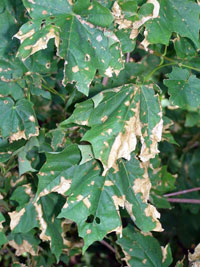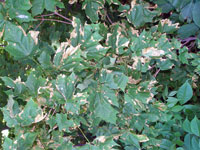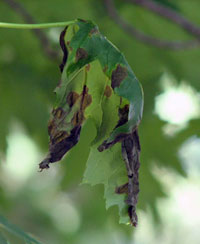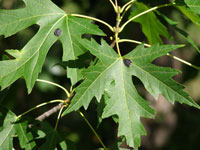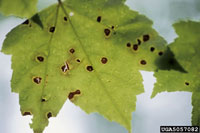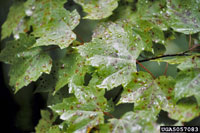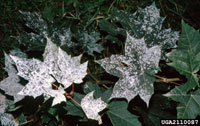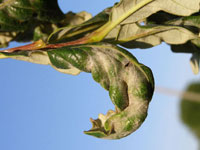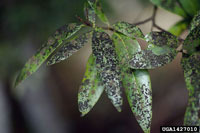Extension > Garden > Diagnose a problem > What's wrong with my plant? > Deciduous Trees > Maple > Spots or blotches on leaves
Maple > Leaves > Spots or blotches on leaves
1 of 5
Anthracnose
Discula campestris, D. umbrinella, Aureobasidium
apocryptum, Colletotrichum gloeosporioides
- Mature leaves have irregularly shaped tan, brown or black leaf spots found along leaf veins; may be curled if severely infected
- Young leaves turn brown to black, shriveled or curled
- Lower, interior branches are most affected
- Damage occurs in wet weather in early spring as leaves are expanding
- More information on Anthracnose
2 of 5
Tar spot
Rhytisma spp.
- Tar spots may be one large black raised spot (1/4-1/2 inch wide) or many small spots clustered together, and often have a yellow halo
- Leaf spots are initially pale green to yellow and are easily overlooked
- In late summer a raised thick black tar-like spot develops on the leaves
- Most common on lower branches, near the center where humidity levels are the highest
- More information on Tar spot
3 of 5
Phyllosticta leaf spot
Phyllosticta minima
- Well-defined, round to irregular spots on leaves with a light-colored center surrounded by a reddish or purplish halo
- Tiny black spots may be visible in the light colored center of the spot
- Discolored areas may eventually merge together to create larger dead areas between the leaf veins
- More information on Phyllosticta leaf spot
4 of 5
Powdery mildew
Phyllactinia guttata
- White or gray powdery mats, resembling talcum powder, occur in spots, blotches or coat leaves
- Lower shaded leaves are most commonly affected, common on small understory trees
- Damage is common in spring or fall
- More information on Powdery mildew
5 of 5
Sooty mold
- Black, brown, or gray soot-like covering on leaf surfaces, or twigs
- Sticky, shiny secretions on leaves from sap-sucking insects (aphids, leaf hoppers, psyllids, etc.)
- Insects or signs of insect damage (distorted, pin-prick feeding marks, etc.) may be seen on leaves above the worst affected moldy areas
- More information on Sooty mold



